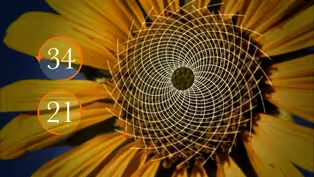
How Music is Made Up of Math
Clip: Season 42 Episode 7 | 2m 1sVideo has Closed Captions
Pythagoras saw a connection between math, music, and nature.
Hear a jazz musician explain how an octave, fifth, and fourth relate to math.
Problems playing video? | Closed Captioning Feedback
Problems playing video? | Closed Captioning Feedback
National Corporate funding for NOVA is provided by Carlisle Companies and Viking Cruises. Major funding for NOVA is provided by the NOVA Science Trust, the Corporation for Public Broadcasting, and PBS viewers.

How Music is Made Up of Math
Clip: Season 42 Episode 7 | 2m 1sVideo has Closed Captions
Hear a jazz musician explain how an octave, fifth, and fourth relate to math.
Problems playing video? | Closed Captioning Feedback
How to Watch NOVA
NOVA is available to stream on pbs.org and the free PBS App, available on iPhone, Apple TV, Android TV, Android smartphones, Amazon Fire TV, Amazon Fire Tablet, Roku, Samsung Smart TV, and Vizio.
Buy Now

NOVA Labs
NOVA Labs is a free digital platform that engages teens and lifelong learners in games and interactives that foster authentic scientific exploration. Participants take part in real-world investigations by visualizing, analyzing, and playing with the same data that scientists use.Providing Support for PBS.org
Learn Moreabout PBS online sponsorship- The ancient Greeks found three relationships between notes especially pleasing.
Now we call them an octave, a fifth, and a fourth.
- An octave is easy to remember because it's the first two notes of "Somewhere Over the Rainbow," ♪ Somewhere ♪ (string bass plays two notes) A fifth sounds like this.
♪ La la ♪ Or the first two notes of ♪ Twinkle Twinkle Little Star ♪ (plucks strings twice) And a fourth sounds like ♪ La la ♪ (plucks strings twice) You can think of it as the first two notes of "Here Comes the Bride."
(plucks strings twice) - In the sixth century BCE, the Greek philosopher Pythagoras is said to have discovered that those beautiful musical relationships were also beautiful mathematical relationships by measuring the lengths of the vibrating strings.
In an octave, the string lengths create a ratio of two to one.
(string bass plays two notes) In a fifth, the ratio is three to two, (string bass plays two notes) and in a fourth, it is four to three.
(string bass plays two notes) - Seeing a common pattern throughout sound, that could be a big eye-opener of saying, "Well, if this exists in sound, and if it's true, universally through all sounds, this ratio could exist universally everywhere, right?"
And doesn't it?
- Pythagoreans worship the idea of numbers.
The fact that simple ratios produced harmonious sounds was proof of a hidden order in the natural world, and that order was made of numbers, a profound insight that mathematicians and scientists continue to explore to this day.
Video has Closed Captions
Clip: S42 Ep7 | 2m 1s | Researchers designed a test to see how well lemurs can compare quantities. (2m 1s)
Video has Closed Captions
Clip: S42 Ep7 | 2m 24s | Evolution seems to favor these numbers. (2m 24s)
Providing Support for PBS.org
Learn Moreabout PBS online sponsorship
- Science and Nature

Capturing the splendor of the natural world, from the African plains to the Antarctic ice.

Winnipeg In Bloom











Support for PBS provided by:
National Corporate funding for NOVA is provided by Carlisle Companies and Viking Cruises. Major funding for NOVA is provided by the NOVA Science Trust, the Corporation for Public Broadcasting, and PBS viewers.




